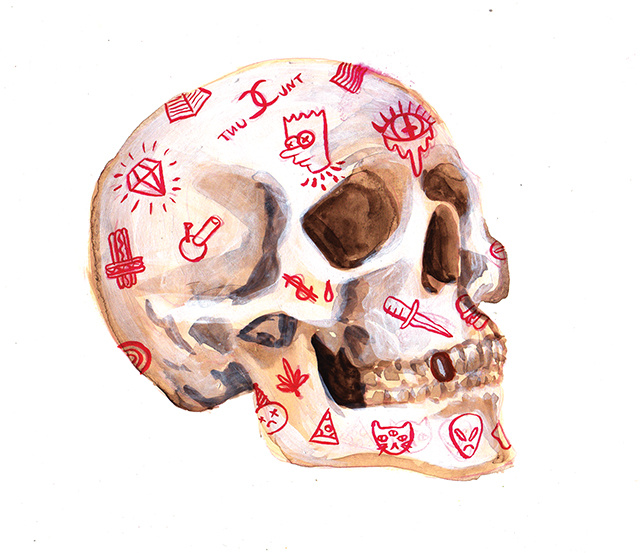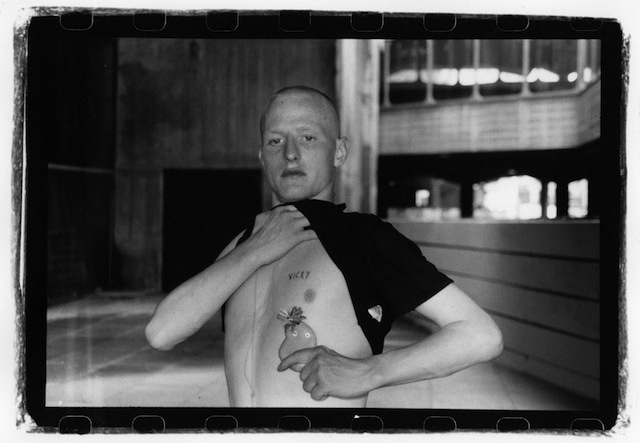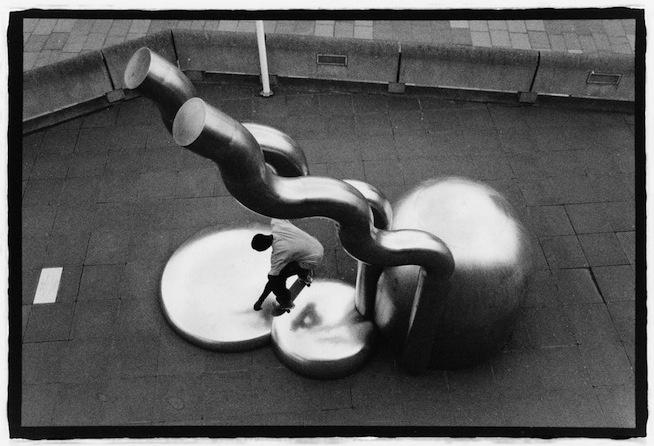![]()
I Left My Lungs in Aamjiwnaang
Breathing the Most Polluted Air in Canada
By Patrick McGuire
![]()
One of the many unintentionally ironic signs in the Chemical Valley.
The first thing you notice about Sarnia, Ontario, is the smell: a potent mix of gasoline, melting asphalt, and the occasional trace of rotten egg. Shortly after my arrival I already felt unpleasantly high and dizzy, like I wasn’t getting enough air. Maybe this had something to do with the bouquet of smokestacks in the southern part of town that, all day every day, belch fumes and orange flares like something out of a Blade Runner-esque dystopia.
Sarnia is home to more than 60 refineries and chemical plants that produce gasoline, synthetic rubbers, and other materials that the world’s industries require to create the commercial products we know and love. The city’s most prominent and profitable attraction is an area about the size of 100 city blocks known as the Chemical Valley, where 40 percent of Canada’s chemical industry can be found packed together like a noxious megalopolis. According to a 2011 report by the World Health Organization, Sarnia’s air is the most polluted air in Canada. There are more toxic air pollutants billowing out of smokestacks here than in all of the provinces of New Brunswick or Manitoba.
Nestled inside this giant ring of chemical production, surrounded on all sides by industrial plants, sits a First Nations reservation called Aamjiwnaang where about 850 Chippewa have lived for over 300 years. Aamjiwnaang was originally a Chippewa hunting ground, but the area was turned into a First Nations reserve in 1827, after the British government snatched up an enormous amount of Native land. Today, it’s one of the most singularly poisonous locations in North America, yet neither the local nor the national government has announced any plan to launch a health study to properly investigate the side effects that are hurting the local residents, who inhale the Chemical Valley’s emissions every time they step outside.
In 2002, the Aamjiwnaang Environmental Committee was founded. This activist group formed in response to a plan by Suncor to build what would have been Canada’s largest ethanol plant right next to the reservation. Suncor is one of Canada’s energy giants that specializes in crude-oil processing—in April of this year, they caught some heat after spilling a chemical used to blend biofuel into a British Columbian inlet. They informed the nearby First Nations people, who live on the inlet, days later. As for their ethanol plant in Aamjiwnaang, Suncor eventually halted construction on the project in response to the Environmental Committee’s protests, and instead built a desulphurization plant next to the reserve’s burial ground.
It wasn’t until the Evironmental Committee came together that people realized how bad things had gotten. I spoke to Wilson Plain, one of the committee’s founders, about Aamjiwnaang’s communal realization that the Chemical Valley was hurting their population. “As a community we were not really aware of what was being released from the plants,” Wilson told me. “When we started having regular meetings of the Environmental Committee, people started recalling how many incidents we had.”
The committee also began commissioning studies, like the one published in 2005 that analyzed birth rates on the reservation. A healthy community should have roughly a 1:1 birth ratio of females to males, but the study found that the Chemical Valley’s ratio had reached nearly 2:1—a statistical anomaly that had never been recorded in any human population, though it has been documented in animal populations that live in extremely polluted areas.
![]()
A protester rallying against more industry coming to the Chemical Valley.
Another study conducted between 2004 and 2005 by the environmental activist organization Ecojustice found that 39 percent of the women in Aamjiwnaang had suffered through at least one stillbirth or miscarriage. Since then, however, there have been no inquiries by federal or local authorities to discern exactly what is causing these abnormalities, let alone any attempt to reverse them. Defenders of the petrochemical industry have brushed off these findings as irrelevant, and similarly shrug at the “anecdotal evidence” offered by Aamjiwnaang residents about the foul smells or the strange ailments that are pervasive in the community.
Here’s an example of anecdotal evidence: In January, the Shell refinery had a “spill,” meaning they accidentally leaked toxic chemicals into the air. The leaked substance included hydrogen sulfide, a highly toxic, potentially lethal substance that was used as a chemical weapon by the British in World War I. The gas floated over to Aamjiwnaang’s daycare center, where the staff and students noticed the air began to smell strongly of rotten eggs. Almost instantly, kids got sick and many were sent to the hospital with headaches, nausea, and skin irritation. For hours, doctors wrongly diagnosed the children as having ordinary flus and colds—if Shell had owned up to the leak that exposed them to hydrogen sulfide, they would almost certainly have gotten better faster.
Christine Rogers has three young girls; one of them was attending Aamjiwnaang’s daycare at the time of the leak, while the other two were riding in a school bus directly through the affected area. “As a parent, you do everything you can to make sure that your children are safe, and when something like that happens, you feel like you’ve lost control,” she told me. “It makes me want to break down and cry when I think about that. What if it had been a bigger spill? You think you’re prepared but really you’re not. It feels helpless.”
Christine went on to explain how she handled the effects of the leak with her eldest: “I told her she needed to tell me about any of the little symptoms that she was experiencing so we could get her to the doctor to see if she’s OK. She had crusted eyes at that point and her eyes were bloodshot for three days, so I had to make sure she didn’t have any infections.”
Parenting in chemical-ridden Aamjiwnaang comes with uniqu-e challenges. While we spoke about her daughters, Christine told me they used to think the Chemical Valley’s massive smokestacks were “cloud makers.” When it came time to tell her children the truth, she came up with a rhyme: “The more clouds in the sky, the more people die.”
Since the incident in January, Shell is believed to have been responsible for two other leaks of hydrogen sulfide—one of them sent three workers to hospital and was still being investigated as of press time. Spills are a regular part of life in Aamjiwnaang. In 2008, the roof of a large tank belonging to Imperial Oil that contained benzene, a well-known carcinogen, collapsed. The entire city of Sarnia was told to stay inside with all of their doors and windows shut.
Often, the responsibility for detecting leaks falls to community members like Ada Lockridge, an Aamjiwnaang Environmental Committee member and outspoken activist who owns an air-testing kit called a Bucket Brigade. This low-tech device consists of a plastic bucket lined with a replaceable plastic bag attached to a vacuum nozzle that protrudes out of the top of the bucket. When Ada suspects the air around her is being polluted by a leak—if it smells like gas or chemicals and tar more than usual—she sucks some of that air down through the vacuum nozzle and into the plastic bag, then sends the bag to a lab in California that for a $500 processing fee will analyze the data and send her a report within two weeks. She used this bucket to detect a hydrogen sulfide leak in April after getting a whiff of a rotten-egg odor she rated as a “ten out of ten” on her personal scale.
Ada describes discovering that leak like this: “My daughter showed up at my house to bring me coffee and a bagel and said, ‘Oh, Mom, it’s terrible out there. It smells like rotten eggs.’ So I got on the phone with the Spills Action Centre [operated by the Ontario government] and told them something was leaking… A lot of times, we’re the ones that notify the companies that they’re leaking. I went outside in my housecoat [with my Bucket Brigade] and told my youngest daughter to plug her nose and run to the school bus.”
This is just part of the heavy price Sarnians have long paid for living in a perpetual boomtown. Oil was first discovered just south of Sarnia in the mid-1800s, and since the city was ideally located—on the banks of the St. Clair River, close to Toronto, Detroit, and Chicago—the petrochemical industry set up shop here. Companies bought land from the people of Aamjiwnaang in the 1940s and 50s, back when the environmental impact of chemical industries was unknown, and in 1942 the first facility in what would become the Chemical Valley opened: a plant owned by Polymer Corporation that manufactured synthetic rubber for the war effort. During the 60s and 70s, the town prospered as the local industry exploded with growth, and the Chemical Valley became such a source of national pride that for several years the smokestack-packed skyline was featured on the back of the Canadian $10 bill.
![]()
Vanessa Gray, a protester from Aamjiwnaang, demonstrating outside an oil-industry conference.
In the decades since we’ve learned much more about the effects these industries have on the environment, and residents find no sense of pride in being surrounded by polluters. Sandy Kinart, who lives in north Sarnia, on the other side of town from Aamjiwnaang, is a lifelong resident of the city. Her husband worked for Welland Chemical as a millwright, assembling and installing machinery for years before dying of mesothelioma, a cancer caused by asbestos exposure. In response she helped found the activist organization Victims of the Chemical Valley. Like many residents who grew up in the “golden age” of Sarnia in the 60s and 70s, she’s only lately come to realize that living near all that industry can be a curse rather than a blessing.
“As a child, driving through Chemical Valley was part of Sunday evening,” she said. “The lights were all on, and boy, that just looked like a fairyland to us. Back in the day, those oil and chemical drums were kept pristine-looking, the gardens around the refineries and plants were beautiful, it was lovely to see. We were proud that we lived in the Chemical Valley… We don’t see that anymore. Now the flowers are dead, the trees are all dying, the drums are all grungy down there; it looks derelict. The industry doesn’t have to keep up the pretense anymore.”
I reached out to several of the petrochemical companies with plants in the Chemical Valley and, after a lot of back and forth, wound up at the desk of Dean Edwardson, general manager of the Sarnia-Lambton Environmental Association, an oil-industry-operated nonprofit. He refused to comment on specific incidents (and acted surprised when I told him about Shell’s two hydrogen-sulfide leaks). But when I pressed him on the January Shell leak that affected the daycare, he admitted that there had been a mistake somewhere along the line. “We had a communication problem,” he said. “Clearly it was unacceptable, and I think if you asked Shell, they would tell you it was unacceptable. Impacting the community is not acceptable, and they regret that incident.”
When I asked Dean how these companies handle the atmosphere of distrust that now permeates Aamjiwnaang and Sarnia due to the leaks, he replied, “I don’t think anyone’s asking anybody to trust the industry. Trust has to be earned and I think our companies are trying to earn that trust.” He also gave me an analogy that awkwardly acknowledged just how bad the situation was: “You can be a great guy, but you go murder somebody, all of a sudden, you’re a murderer.”
Dean also pointed out that Sarnia’s air quality wasn’t helped by what he called “transboundary migration of contaminants from our friends to the south.” In other words, roughly half of Sarnia’s pollution has floated into the city from American smokestacks. Detroit lies just a few dozen miles to the south and is similarly scarred by Canadian pollution—on the banks of the Detroit River, in a poor area of town, sits a three-story-high pile of petroleum coke that stretches the length of a city block. The pile’s owner, Koch Carbon (part of the infamous megacorporation Koch Industries, run by the Koch brothers), doesn’t seem to care to do anything about it either. As a headline in the New York Times this May put it, “A Black Mound of Canadian Oil Waste Is Rising Over Detroit.”
![]()
Chemical Valley seen from a small plane.
Just across the river from the coke pile lives Jim Brophy, a scientist and health expert who has studied pollution and human health in Sarnia and Aamjiwnaang for decades. (Jim and his wife Margaret helped discover the Aamjiwnaang birth-ratio anomaly.) I visited Jim to learn more about the problem of “cumulative effects,” which works like this: one petrochemical plant is legally allowed to produce a certain amount of Pollutant A, and another plant down the road is allowed to produce a different amount of Pollutant B—but no one knows what happens when A and B meet and combine in the air above a populated area like Aamjiwnaang. The Chemical Valley’s atmosphere is full of an unsettlingly unregulated, dangerous cocktail of poisons.
“The levels of toxic exposure we have in Ontario is not safe by any stretch of the imagination,” Jim said. “The most at-risk communities are First Nations on the fence lines, the blue-collar workers in those plants, the poor working class who live in south Sarnia… It’s not the CEOs.”
The mayor of Sarnia, Mike Bradley, seems sympathetic to the concerns of some environmentalists, though he also has a politician’s habit of hedging everything he says. “You’re never going to win by advocating for the oil industry in the realm of public opinion,” he said. “The reality is you cannot function in your daily life without the plastic, chemical, and petrochemical sector.”
The mayor did express some support for conducting a study on the people most affected by the Chemical Valley’s emissions; however, he said that there isn’t enough government funding in place to support the research needed for the study. For at least the time being, the long-term effects of living under the chemical haze of Sarnia will continue to be unknown.
Jim thinks that the blame for this can be laid at the feet of politically influential oil companies. “In countries where petrochemical industry has substantial power, there’s a real deficit of democracy,” he said. “We live in a situation now in Canada where the oil industry has tremendous power. Some would say they literally have a lock on the federal government. So when you’re in a community like Sarnia, where they have tremendous clout, and there’s fear of plant closures and downsizing and so forth, the Department of the Environment doesn’t act as a counterweight to that industry. It falls then to the Ada Lockridges of the world to stand up to this… Where the hell is the federal government? Where the hell is the provincial government? What are we doing here? Have all the protections and the democratic rights of our society collapsed?”
Right now the task of pushing back against pollution falls to smaller organizations like Sandy Kinart’s Victims of the Chemical Valley, and they can only do so much. In 2003, the group helped erect a monument to those who died from working in the refineries and factories in beautiful waterfront Centennial Park. It was nice while it lasted, but this spring, much of the park was closed after an excessive amount of asbestos was found in the soil. When I visited, I couldn’t get in and there was no official signage explaining why the park was shuttered.
Wandering around the exterior of the park, I found two sticky notes that had been left on the chain-link fence that blocked the entrance. On them, an anonymous Sarnian had distilled the situation quite simply in cursive handwriting: “This is a memorial for those who died and suffered because of the Chemical Valley. It’s behind a fence because the government found out that this park is also polluted by toxic chemicals.”
More from the Hot Box Issue:
It’s Good to Be the King
The Ghost Rapes of Bolivia
It Don’t Gitmo Better Than This












































































